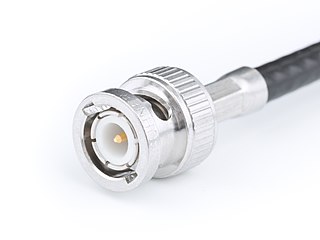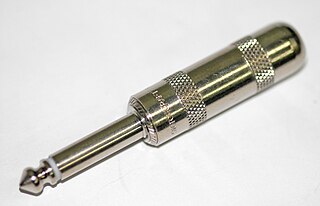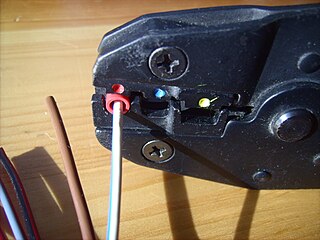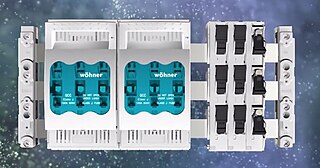
Coaxial cable, or coax is a type of electrical cable that has an inner conductor surrounded by a tubular insulating layer, surrounded by a tubular conducting shield. Many coaxial cables also have an insulating outer sheath or jacket. The term coaxial comes from the inner conductor and the outer shield sharing a geometric axis. Coaxial cable was used in the first (1858) and following transatlantic cable installations, but its theory wasn't described until 1880 by English physicist, engineer, and mathematician Oliver Heaviside, who patented the design in that year.

The BNC connector is a miniature quick connect/disconnect radio frequency connector used for coaxial cable.

An electrical connector is an electromechanical device used to join electrical conductors and create an electrical circuit. Most electrical connectors have a gender – i.e. the male component, called a plug, connects to the female component, or socket. The connection may be removable, require a tool for assembly and removal, or serve as a permanent electrical joint between two points. An adapter can be used to join dissimilar connectors.

The N connector is a threaded, weatherproof, medium-size RF connector used to join coaxial cables. It was one of the first connectors capable of carrying microwave-frequency signals, and was invented in the 1940s by Paul Neill of Bell Labs, after whom the connector is named.

A phone connector, also known as phone jack, audio jack, headphone jack or jack plug, is a family of electrical connectors typically used for analog audio signals.
American wire gauge (AWG), also known as the Brown & Sharpe wire gauge, is a logarithmic stepped standardized wire gauge system used since 1857, predominantly in North America, for the diameters of round, solid, nonferrous, electrically conducting wire. Dimensions of the wires are given in ASTM standard B 258. The cross-sectional area of each gauge is an important factor for determining its current-carrying ampacity.
Rolled homogeneous armour (RHA) is a type of armour made of a single steel composition hot-rolled to improve its material characteristics, as opposed to layered or cemented armour. Its first common application was in tanks. After World War II, it began to fall out of use on main battle tanks and other armoured fighting vehicles intended to see front-line combat as new anti-tank weapon technologies were developed which were capable of relatively easily penetrating rolled homogeneous armour plating even of significant thickness.

SMA connectors are semi-precision coaxial RF connectors developed in the 1960s as a minimal connector interface for coaxial cable with a screw-type coupling mechanism. The connector has a 50 Ω impedance. SMA is designed for use from DC (0 Hz) to 18 GHz, and is most commonly used in microwave systems, hand-held radio and mobile telephone antennas, and more recently with WiFi antenna systems and USB software-defined radio dongles. It is also commonly used in radio astronomy, particularly at higher frequencies (5 GHz+).

Electrical wiring is an electrical installation of cabling and associated devices such as switches, distribution boards, sockets, and light fittings in a structure.
MIL-STD-1553 is a military standard published by the United States Department of Defense that defines the mechanical, electrical, and functional characteristics of a serial data bus. It was originally designed as an avionic data bus for use with military avionics, but has also become commonly used in spacecraft on-board data handling (OBDH) subsystems, both military and civil. It features multiple redundant balanced line physical layers, a (differential) network interface, time division multiplexing, half-duplex command/response protocol, and can handle up to 30 Remote Terminals (devices). A version of MIL-STD-1553 using optical cabling in place of electrical is known as MIL-STD-1773.
A United States defense standard, often called a military standard, "MIL-STD", "MIL-SPEC", or (informally) "MilSpecs", is used to help achieve standardization objectives by the U.S. Department of Defense.
The military specification referred to as MIL-DTL-5541, "Military Specification, Chemical Conversion Coatings on Aluminum and Aluminum Alloys" covers chemical conversion coatings formed by the reaction of chemical conversion materials with the surfaces of aluminum and aluminum alloys. The current specification (2009) is MIL-DTL-5541F, which superseded MIL-C-5541E in July 2006. The specification is approved for use by all departments and agencies of the United States Department of Defense (DoD). Although prepared specifically for DoD applications, the standard is used for many commercial applications as well. It has gained world wide use across many fields versus the more verbose ISO equivalent. Note that chromate conversion coatings have been used for over 50 years as treatment to coated or as-fabricated surfaces to boost corrosion resistance and provide a good basis for the subsequent application of paint. However, these treatments use hexavalent chromium chemicals that are extremely toxic. This has led to progressively greater restrictions, imposed by national and international legislation, related to concerns over health and safety and environmental protection, on the use of these treatments.

A cable harness, also known as a wire harness, wiring harness, cable assembly, wiring assembly or wiring loom, is an assembly of electrical cables or wires which transmit signals or electrical power. The cables are bound together by a durable material such as rubber, vinyl, electrical tape, conduit, a weave of extruded string, or a combination thereof.

RG-6/U is a common type of coaxial cable used in a wide variety of residential and commercial applications. An RG-6/U coaxial cable has a characteristic impedance of 75 ohms. The term, RG-6, is generic and is applied to a wide variety of cable designs, which differ from one another in shielding characteristics, center conductor composition, dielectric type and jacket type. RG was originally a unit indicator for bulk radio frequency (RF) cable in the U.S. military's Joint Electronics Type Designation System. The suffix /U means for general utility use. The number was assigned sequentially. The RG unit indicator is no longer part of the JETDS system (MIL-STD-196E) and cable sold today under the RG-6 label is unlikely to meet military specifications. In practice, the term RG-6 is generally used to refer to coaxial cables with an 18 AWG center conductor and 75 ohm characteristic impedance.
EIA RF Connectors are used to connect two items of high power radio frequency rigid or semi-rigid (flexline) coaxial transmission line. Typically these are only required in very high power transmitting installations where the feedline diameters may be several inches. One side of the connection is denoted as a male connection, or bullet, while the other side is denoted as the female connection, or cup. The EIA under the Electronic Components Industry Association, are responsible for a number of standard imperial connector sizes.

Electrical or fiber-optic connectors used by U.S. Department of Defense were originally developed in the 1930s for severe aeronautical and tactical service applications, and the Type "AN" (Army-Navy) series set the standard for modern military circular connectors. These connectors, and their evolutionary derivatives, are often called Military Standard, "MIL-STD", or (informally) "MIL-SPEC" or sometimes "MS" connectors. They are now used in aerospace, industrial, marine, and even automotive commercial applications.

MIL-DTL-5015 is a United States Military Standard which covers heavy-duty circular electrical connectors with soldered or crimped contacts. They are used for both digital and analog signals, as well as power distribution, and are common in various fields, including defense, aerospace, and industrial machinery. The connectors are particularly versatile and reliable, and due to their prevalence, relatively inexpensive.

An electrical crimp is a type of solderless electrical connection.

Military Specification MIL-S-901D is a military specification for High Impact mechanical shock which applies to equipment mounted on ships. Two levels apply. Grade A items are items which are essential to the safety and continued combat capability of the ship. Grade B items are items whose operation is not essential to the safety and combat capability of the ship but which could become a hazard to personnel, to Grade A items, or to the ship as a whole as a result of exposure to shock. "Grade C", signifying that no shock qualification is required, is also sometimes referenced in acquisition documents even though the term has no official standing in the specification document.. Qualification testing is performed on a specified machine or on a barge floating in a pond where an explosive charge is detonated at various distances and depths in the pond to impart shock to the barges. See Barge Test.

Electrical busbar systems are a modular approach to electrical wiring, where instead of a standard cable wiring to every single electrical device, the electrical devices are mounted onto an adapter which is directly fitted to a current carrying busbar. This modular approach is used in distribution boards, automation panels and other kinds of installation in an electrical enclosure.













